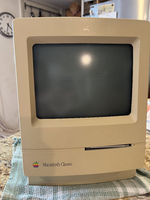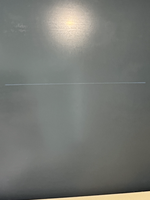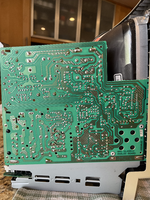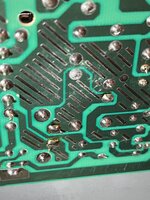SparrowRat
Active member
Hi all, I recently got my first compact mac, a Mac Classic, for only $20! It came with the original keyboard, mouse, manuals, boot floppy, and system 7 disks. It's has the ram expansion board with both slots populated for I believe 4 MBs? and the original SCSI hard drive.
Unfortunately, upon booting it up, it displayed a thin line across (most of) the screen.


After buying the right screwdriver, I opened it and removed the logic board. There was no PRAM battery leakage but 6 capacitors had fallen off, taking their pads with them, and it looked like the rest of the caps were corroding at their pads as well. As for replacing them, I have a fair amount of experience in through-hole soldering but no experience at all in surface mount. I assume that even though the logic board is faulty/dead at least something more than a line would show on screen

I also took off the analog board back cover and it looks like some of the solder joints there are not great. I can't see any capacitors leaking on the analog board but I would need to remove it to really look.

What would you recommend as my next steps?
Unfortunately, upon booting it up, it displayed a thin line across (most of) the screen.


After buying the right screwdriver, I opened it and removed the logic board. There was no PRAM battery leakage but 6 capacitors had fallen off, taking their pads with them, and it looked like the rest of the caps were corroding at their pads as well. As for replacing them, I have a fair amount of experience in through-hole soldering but no experience at all in surface mount. I assume that even though the logic board is faulty/dead at least something more than a line would show on screen

I also took off the analog board back cover and it looks like some of the solder joints there are not great. I can't see any capacitors leaking on the analog board but I would need to remove it to really look.

What would you recommend as my next steps?
Last edited:

